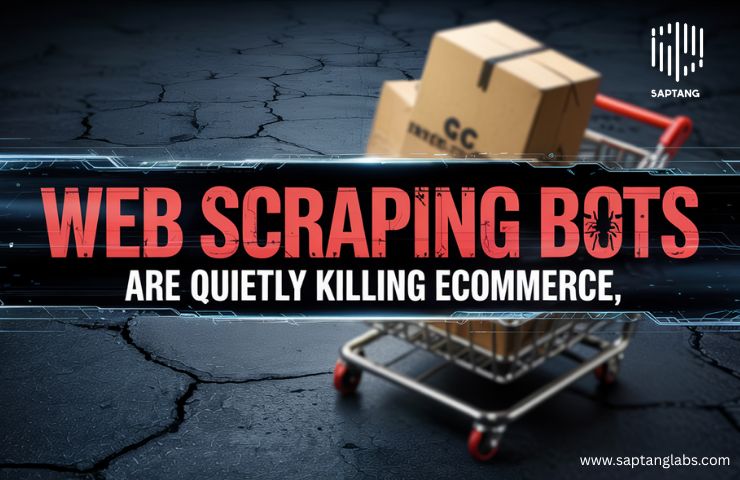I’ve worked in cybersecurity long enough to know that not every threat kicks down the front door. Some threats creep in slowly. Quietly. And often, the most damaging ones are the ones you never saw coming.
Right now, web scraping bots are doing just that to ecommerce businesses.
They don’t trip alarms. They don’t break things in flashy ways. But they’re eating away at your site’s performance, your customer trust, and yes — your revenue.
Let me break down why this matters, what I’ve seen firsthand, and what you can do before it’s too late.
The Bots You Didn’t Hire
Web scraping bots are designed to do one thing: collect data from your website.
Some of them are harmless — they power price comparison tools or SEO crawlers. But increasingly, I’m seeing bots that are anything but harmless.
- They steal product descriptions, prices, and images.
- They scan inventory levels in real-time.
- Some even simulate real user behavior to avoid detection.
In one case, we saw a competitor mirror a client’s entire site, products and all, with fake checkout pages. These weren’t rookies — the bots were sophisticated, and they were fast.
Real Numbers, Real Damage
According to Akamai’s 2024 bot traffic report, 42% of all web traffic is bot-driven, and 65% of that is classified as malicious. Let that sink in.
More than one-third of what hits your site might not even be human.
From my own logs and reports across ecommerce platforms, I’ve seen bot traffic:
- Inflate bounce rates and skew conversion metrics.
- Increase server load by 30–50% during peak sales periods.
- Trigger rate-limiting that impacts real users.
The scary part? Most teams don’t realize it until a breakdown happens — a site outage on Black Friday, weird customer complaints, or a sudden drop in ad performance.
This Isn’t Just A Security Problem — It’s a Business One
When I bring this up to leadership teams, the first question is usually, “So what? They’re just copying data, right?”
But here’s what I show them:
➤ Lost Competitive Edge
If a competitor knows your prices, discounts, and inventory trends before you even launch them — they can outmaneuver you before you’ve made a move.
➤ Polluted Analytics
Bots click, scroll, even fake session behaviors. That means your A/B tests, user journeys, and funnel optimizations could be built on garbage data.
➤ Wasted Infrastructure Spend
Most ecommerce sites pay for CDN bandwidth, cloud compute, and API requests based on usage. Bots can drive those costs through the roof — and they don’t convert.
➤ Brand Damage
When scrapers create fake sites using your content, your logo, and your products, they’re not just stealing traffic. They’re creating potential fraud risks — and you take the blame.
AI Makes It Worse
A year ago, basic bot filters might have done the trick. Not anymore.
The latest scraping bots are using AI to mimic human behavior. I’ve watched sessions that:
- Scroll the page in realistic patterns
- Wait for content to load before extracting it
- Randomize timing and mouse movement
And they don’t all come from shady data centers anymore. Many operate from residential IPs or hijacked devices — making them look like legit traffic.
This is why traditional security solutions often miss them.
What I Recommend (From Experience)
Here’s what I advise every ecommerce platform I work with:
Get Serious About Bot Management
Invest in a solution that can detect and respond to bots based on behavior — not just IP reputation. You need to distinguish between good bots, bad bots, and real users with nuance.
Build in Traps
Create hidden fields, invisible links, or fake URLs that only bots interact with. We’ve caught thousands this way — and it helps improve detection models.
Protect Critical Endpoints
Your pricing APIs, cart logic, and inventory systems should have throttling, authentication, or fingerprinting. Bots will go after these first.
Log Everything, Then Review
Monitor traffic sources, sudden surges, and repeated patterns. Over time, these logs will show you what your standard looks like — so anomalies stand out.
Educate Your Team
Marketing, sales, and analytics teams often suffer most from bot activity. Help them understand what bot traffic looks like so they’re not optimizing against false signals.
One Last Thing — Don’t Wait for a Disaster
Most people don’t take web scraping seriously until it hurts.
But by then, you’re already cleaning up after the fact — refunding scammed customers, explaining outages, or rolling back bad data decisions.
I’ve seen companies spend millions on brand-building, only to lose customer trust to a fake site copying their listings. I’ve seen beautiful sites crash during major sales because of bot spikes.
It’s preventable. But only if you act before the damage is done.
Final Thoughts
Web scraping bots aren’t just a tech problem — they’re a business risk hiding in plain sight. And while you won’t stop every one of them, you can make their job a lot harder.
As someone who’s watched these threats evolve from the inside, trust me when I say: the cost of doing nothing is almost always higher than the cost of acting early.
If your ecommerce platform is growing — bots are coming. Let’s make sure they’re not the ones profiting.
You may also like this: How to Prevent Phishing Scams in 2025: What You Need to Know


